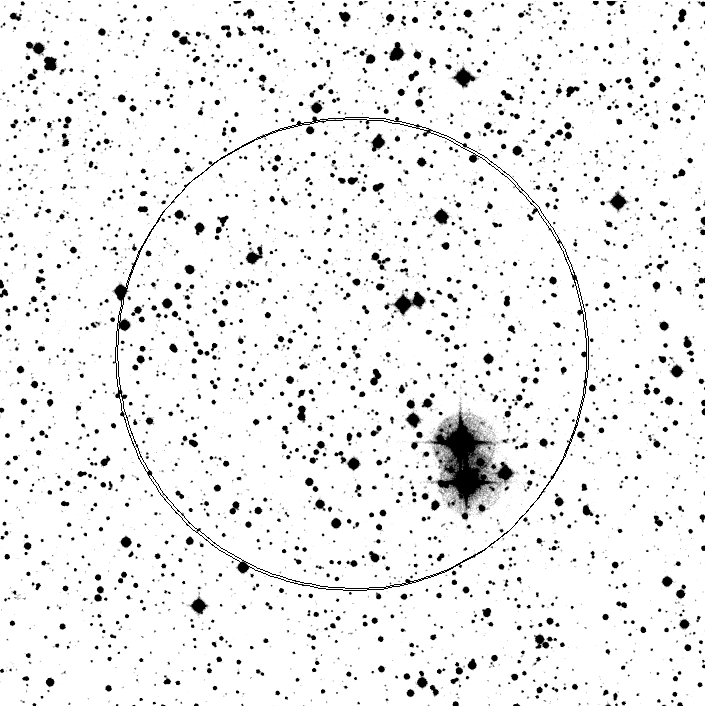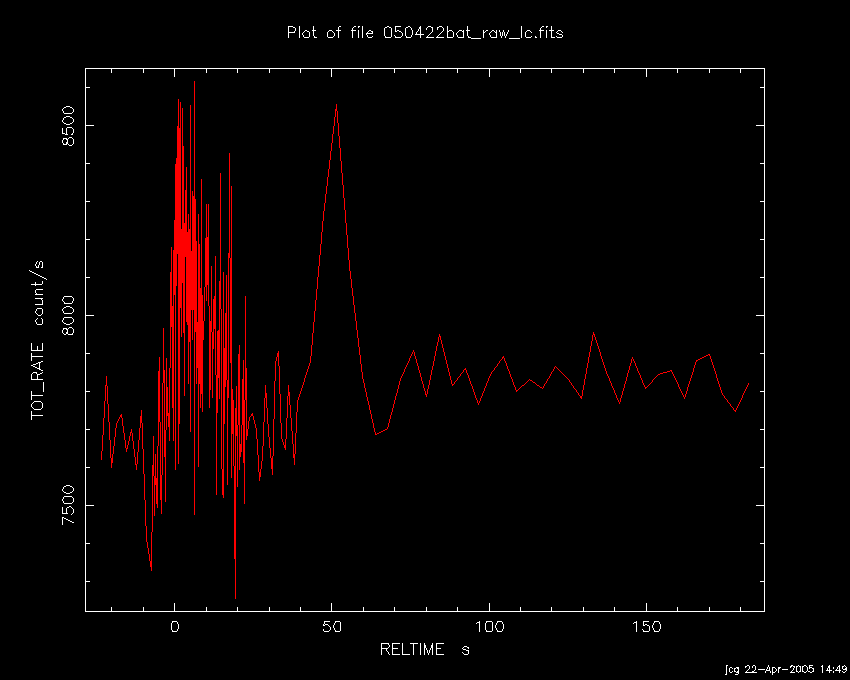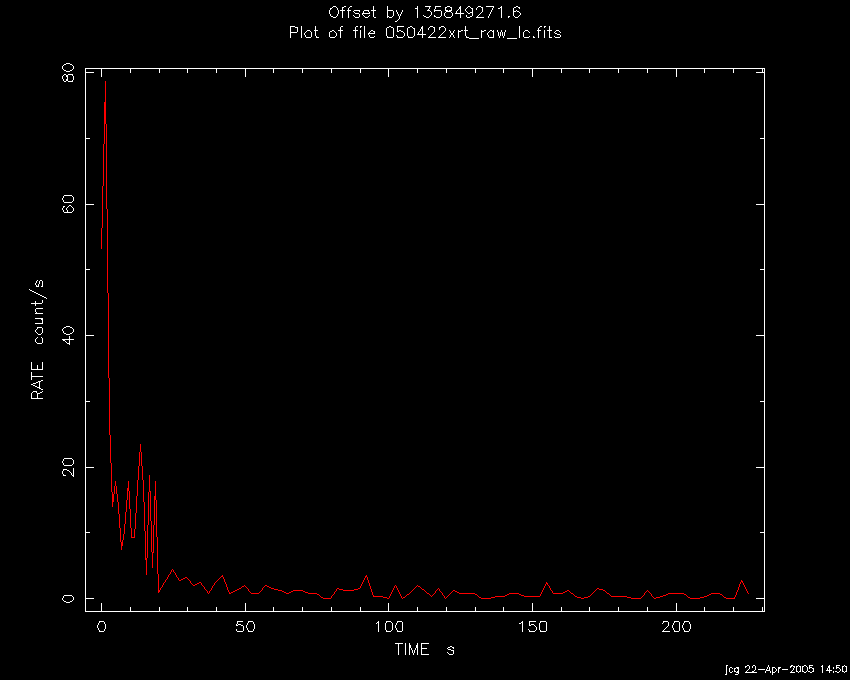(All information courtesy of the instrument teams.)
![]() Previous IAU Circulars
Previous IAU Circulars
TITLE: GCN/SWIFT NOTICE
NOTICE_DATE: Fri 22 Apr 05 08:07:26 UT
NOTICE_TYPE: Swift-XRT Position
TRIGGER_NUM: 115214, Seg_Num: 0
GRB_RA: 324.4306d {+21h 37m 43s} (J2000),
324.4733d {+21h 37m 54s} (current),
324.0284d {+21h 36m 07s} (1950)
GRB_DEC: +55.7844d {+55d 47' 04"} (J2000),
+55.8084d {+55d 48' 30"} (current),
+55.5585d {+55d 33' 31"} (1950)
GRB_ERROR: 5.8 [arcsec radius, statistical plus systematic]
GRB_INTEN: 56100.00 [arb]
GRB_SIGNIF: 5.09 [sigma]
GRB_DATE: 13482 TJD; 112 DOY; 05/04/22
GRB_TIME: 28469.37 SOD {07:54:29.37} UT
TAM[0-3]: 327.64 237.19 261.38 242.12
AMPLIFIER: 2
WAVEFORM: 135
SUN_POSTN: 30.11d {+02h 00m 25s} +12.27d {+12d 16' 07"}
SUN_DIST: 66.28 [deg]
MOON_POSTN: 186.76d {+12h 27m 02s} -1.25d {-01d 15' 03"}
MOON_DIST: 115.70 [deg]
MOON_ILLUM: 95 [%]
GAL_COORDS: 98.03, 2.58 [deg] galactic lon,lat of the burst
ECL_COORDS: 3.61, 62.72 [deg] ecliptic lon,lat of the burst
COMMENTS: SWIFT-XRT Coordinates.
COMMENTS: WARNING: XRT alignment calibration is on-going, and there may be
COMMENTS: residual systematic offsets of several arcseconds not accounted for yet
COMMENTS: by our on-board position determination algorithm. We have increased
COMMENTS: the estimated error circle radius to take this into account.
COMMENTS: The 'object' found for this position is very likely a cosmic ray hit in the CCD; not a burst afterglow.

TITLE: GCN/SWIFT NOTICE
NOTICE_DATE: Fri 22 Apr 05 08:08:10 UT
NOTICE_TYPE: Swift-BAT GRB Lightcurve
TRIGGER_NUM: 115214, Seg_Num: 0
GRB_RA: 324.454d {+21h 37m 49s} (J2000),
324.497d {+21h 37m 59s} (current),
324.052d {+21h 36m 13s} (1950)
GRB_DEC: +55.799d {+55d 47' 55"} (J2000),
+55.823d {+55d 49' 22"} (current),
+55.573d {+55d 34' 22"} (1950)
GRB_DATE: 13482 TJD; 112 DOY; 05/04/22
GRB_TIME: 28359.80 SOD {07:52:39.80} UT
TRIGGER_INDEX: 478
GRB_PHI: -35.03 [deg]
GRB_THETA: 19.15 [deg]
DELTA_TIME: 71.00 [sec]
LC_URL: sw00115214000msb.lc
SUN_POSTN: 30.10d {+02h 00m 25s} +12.27d {+12d 16' 06"}
SUN_DIST: 66.27 [deg]
MOON_POSTN: 186.75d {+12h 26m 59s} -1.24d {-01d 14' 35"}
MOON_DIST: 115.70 [deg]
MOON_ILLUM: 95 [%]
GAL_COORDS: 98.05, 2.58 [deg] galactic lon,lat of the pointing direction
ECL_COORDS: 3.65, 62.72 [deg] ecliptic lon,lat of the pointing direction
COMMENTS: SWIFT-BAT GRB Lightcurve.
COMMENTS: This does not match any source in the ground catalog.

TITLE: GCN/SWIFT NOTICE
NOTICE_DATE: Fri 22 Apr 05 08:08:54 UT
NOTICE_TYPE: Swift-XRT Lightcurve
TRIGGER_NUM: 115214, Seg_Num: 0
POINT_RA: 324.431d {+21h 37m 43s} (J2000)
POINT_DEC: +55.806d {+55d 48' 23"} (J2000)
LC_START_DATE: 13482 TJD; 112 DOY; 05/04/22
LC_START_TIME: 28472.11 SOD {07:54:32.11} UT
LC_STOP_DATE: 13482 TJD; 112 DOY; 05/04/22
LC_STOP_TIME: 28699.75 SOD {07:58:19.75} UT
LC_LIVE_TIME: 223.98 [sec], 98.4%
DELTA_TIME: 86172.36 [sec]
N_BINS: 100
TERM_COND: 0
LC_URL: sw00115214000msx.lc
SUN_POSTN: 30.11d {+02h 00m 25s} +12.27d {+12d 16' 07"}
SUN_DIST: 66.28 [deg]
MOON_POSTN: 186.76d {+12h 27m 02s} -1.25d {-01d 15' 04"}
MOON_DIST: 115.69 [deg]
MOON_ILLUM: 95 [%]
GAL_COORDS: 98.04, 2.60 [deg] galactic lon,lat of the pointing direction
ECL_COORDS: 3.64, 62.74 [deg] ecliptic lon,lat of the pointing direction
COMMENTS: SWIFT-XRT Lightcurve.

RA(J2000) = 21:37:54.5, Dec(J2000) = +55:46:46.6.We estimate an uncertainty of about 5 arcseconds radius (90% containment). This position is 84 arcseconds from the BAT position reported in GCN 3314.
Filter Upper Limit Duration(s) T_start(s) T_mid(s) V 17.9 148.7 112.9 374.1 B 18.2 48.8 258.6 432.5 U 17.8 48.8 244.5 418.0Where T_start is time after trigger, and T_mid is the midpoint of the summed exposure.